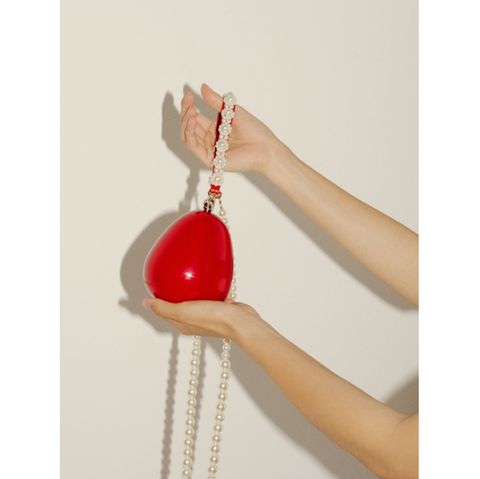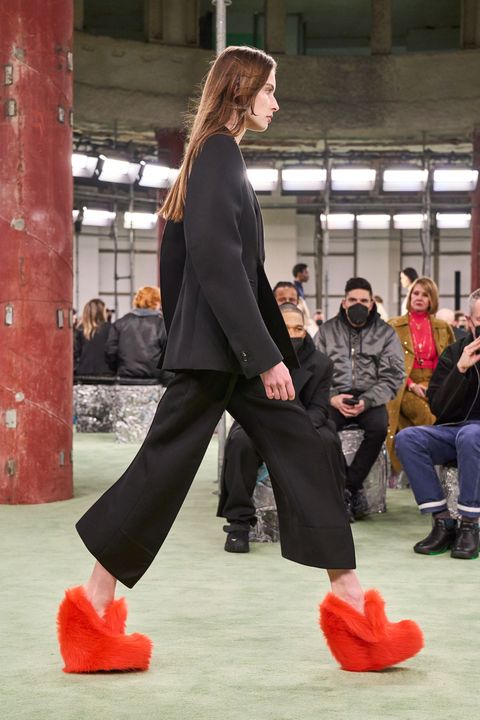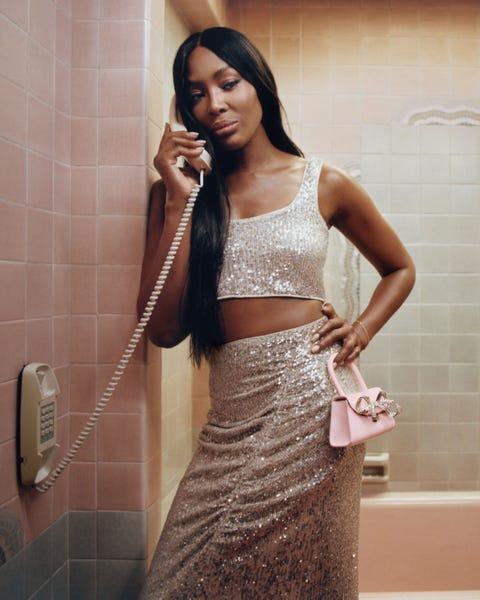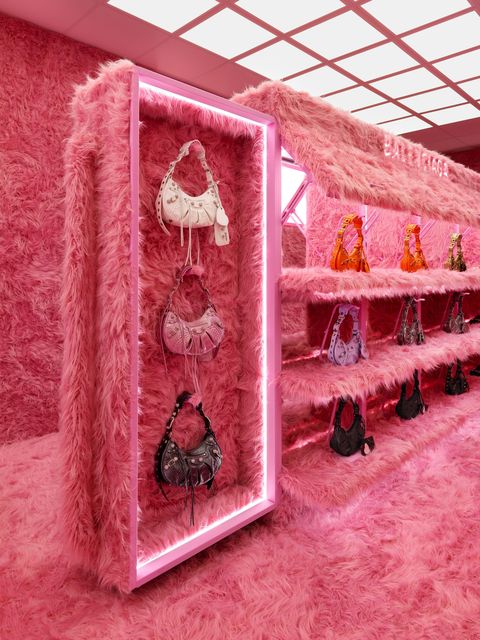It Bags were over in 2008, or so declared trend pieces in the New York Times and Wall Street Journal. In the face of the biggest financial collapse since the Great Depression, the very notion of those symbols of turn-of-the-century conspicuous consumption—the Fendi Baguettes, the Chloé Paddingtons, the Dior Saddles, and many others that cost $1,000 or more, an astounding amount at the time—suddenly seemed vulgar. There were reports of the superrich camouflaging their Birkins inside drugstore shopping bags.
Funny how quaint that all sounds today, when prices of some of the most covetable bags of the season now approach five figures, and the resale market for bygone icons like Louis Vuitton’s Takashi Murakami collaborative series has become an industry unto itself. But times have changed, and what appears to be a resurgence of notably bigger and bolder accessories (and not just bags) on the runways in fact marks a more nuanced approach to designing for an audience that has come to appreciate statement-making excess as an investment opportunity.
“The more fantastical the accessory, the better in this moment,” says Paul Andrew, the former Ferragamo creative director, who relaunched his signature footwear collection for fall. While Andrew was once pegged as an aspirant to the throne of Manolo for his uptown, ladylike style, his new collection is decidedly flashier, with glittering plexiglass wedges and Swarovski crystal heels, inspired by what he sees as a return to the ’90s-era eroticism of Tom Ford at Gucci. “People have this pent-up desire to get dressed up again after years of being at home,” Andrew says. “There’s also this Instagram culture, where everything is more sexual,” not to mention shows like Elite and Euphoria “that are very forward in the way that youth present themselves and their bodies.”
Interestingly, after years of seeing accessories shrink to comically small proportions, like the dollhouse-scale Jacquemus Le Chiquiti, the fall collections highlighted showpieces that seemed only to grow more exaggerated in their theatricality, from Jonathan Anderson’s silver Bow Sandal at Loewe (described by the house as featuring “chaotic volume”) to Nicolas Ghesquière’s latest take on the Vuitton monogram: shiny-surfaced bags that grew larger by the look. There are many theories as to why, none so obvious as the desire to move on from the misery of the pandemic. Han Chong, the founder and creative director of the London-based Self-Portrait collection, says he was chatting with friends about his nostalgia for the relatively less stressful ’90s when he came up with the idea for the Bow Bag, a pert-and-perky purse that has been a social media hit since Naomi Campbell introduced it in June with a campaign that spoofed the 1998 Brandy and Monica hit “The Boy Is Mine.”
“That was a time when everything was inspired by music videos, and people were having a lot of fun,” Chong says. “It’s this very simple idea, but maximum impact.” Daniel Roseberry, artistic director of Schiaparelli, also sees a ’90s connection in how musicians and artists influence fashion and pop culture today. “It feels similar in the sense that a little vulgarity feels relevant, as long as it’s done with a sense of humor and a lot of charm,” he says.
In the past, It Designs seemed so calculated that “it became like running a candidate,” says Cameron Silver, the vintage retailer and multifaceted designer. “It’s like, ‘How many test groups has this bag gone through?’ ” But seeing these items’ prices continue to soar has trained consumers to shop with an eye to their potential value, which in turn is helping to drive their resurgence, he says. Not for nothing did the Credit Suisse Research Institute recently classify Chanel handbags as one of the top items to collect for inflation protection, up there with traditional Chinese artworks and luxury wristwatches. “It’s more like investment shopping,” Silver says. “My friend’s daughter really wants a particular Gucci bag for her 18th birthday. She’s paying attention to the aftermarket for this $3,200 bag. There’s a lot more confidence in handbags, and shoes too.”
Luxury brands are also more sensitive to the downsides of oversupply, and in some cases are producing their buzziest designs in limited quantities—“Insider It Bags,” as Silver calls them. Coperni’s glass version of its Swipe bag (a lozenge shape that resembles the “Tap to unlock” feature on a cellphone), produced by the Brooklyn-based glassblower Heven, is an extreme example of a fashion item that borders on wearable art. But even pieces with high social media visibility, like Schiaparelli’s pricey Anatomy bags, with faces rendered in bijoux, are very hard to come by in stores, further enhancing their desirability.
“This is more important nowadays to consumers than it was back in the ’90s,” says Morgane Halimi, head of handbags and accessories at Sotheby’s. “You want to invest in two aspects: long-lasting pieces, and pieces that are able to retain value.” Her pick today would be Chanel’s Heart bag, another ’90s throwback revived by designer Virginie Viard in the spring 2022 collection. “It’s extremely desirable, and the heart shape makes it a fun accessory, playing with the classic Chanel quilted pattern,” Halimi says. Jodi Kahn, vice president of luxury fashion at Neiman Marcus, says customers are going for bolder accessories from Versace and Balenciaga, noting that just as in the early 2000s, “logos are back and in high demand,” though they are less splashy today. “Now the recognizability of the highest-trending bags is determined by multiple factors: the quality of the materials, colors, shapes, monogram, and logo,” Kahn says. Standouts from her wish list include Saint Laurent’s crossbody Cassandra and the One Stud Satchel from Valentino.
And Tiffany Hsu, fashion buying director at Mytheresa, notes that the increase in travel, galas, and weddings has also driven interest in statement accessories that can be worked into an everyday wardrobe. “For example, bags like the Balenciaga Le Cagole are available in many different versions that can be worn day or night,” she says. “A recent favorite, the Prada Cleo, comes in a fully bedazzled option that can be paired with jeans and a white button-down for an everyday outfit that still makes a statement.”
That sentiment certainly resonates with designers like Roseberry. “Because of social media, I think it’s getting harder and harder to find everyday situations that don’t merit something extraordinary—a crazy bag or a Surrealist shoe or really oversize jewelry,” he says. “So much of going out feels performative now, so I think the louder the better.”
Main Image Credit: Sandal, Loewe, $950, select Loewe Boutiques nationwide. Prop Stylist: Gözde Eker.
This article appears in the October 2022 issue of ELLE.
Eric Wilson is a veteran fashion reporter currently based in Hong Kong, where he is editorial director of Tatler Asia Group. He was previously a reporter at The New York Times and WWD, and fashion news director at InStyle in New York.
The ‘It’ Accessory Is Officially Back
News Reports PH





0 Comments